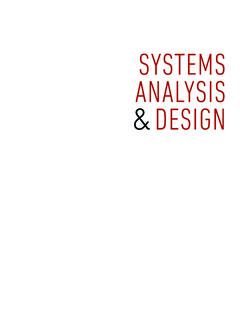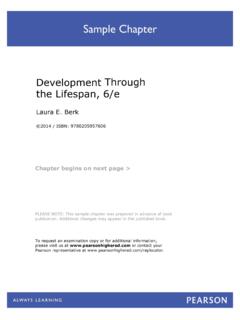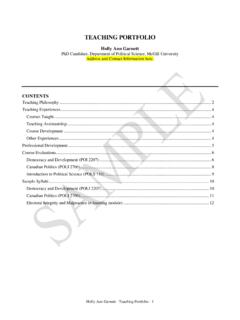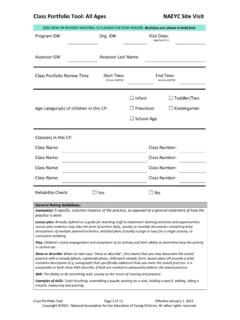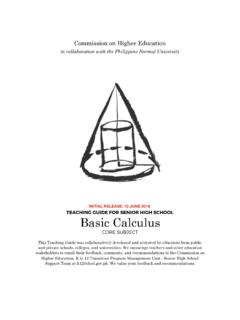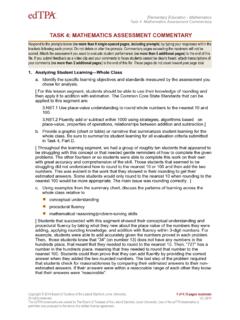Transcription of Portfolio Development - Pearson
1 102 Portfolio DevelopmentWHAT IS A Portfolio ?When individuals hear the word Portfolio ,many different images come to think of compiling their best work ( , paintings, pottery, portraits, andsculptures) for review, whereas a Portfolio for teachers often contains gatheredsamples of lesson plans, units of study, and professional documents that reflectthe knowledge, skills, and beliefs of the teacher. In today s digital world, portfo-lios are often times presented in a variety of formats, including through web-sites, on CDs or DVDs, or through various the artist s Portfolio describes each piece of art in writing, givingdetails about artistic design, teachers portfolios describe their success and thatof their masterpieces, their students. Teachers who develop portfolios reflecton each piece of work, highlighting the strengths and weaknesses, as well asthe changes they would make in their teaching related to student success.
2 Theteacher s Portfolio is used for self-evaluation or external review. Both of theseimages are correct representations of portfolios, because they both have severalspecific have a specific purpose. The artist s Portfolio shows his or her artisticabilities, whereas the teacher s Portfolio shows his or her knowledge,skills, and abilities related to are developed for a specific audience. The artist s audience is a poten-tial employer, and the teacher s is himself or herself or external contain work samples, commonly called evidence. Evidence is the stuff or things that are put into the Portfolio . The artist s evidencewould be the paintings, pottery, portraits, and sculptures. The teacher sevidence would include student work, lesson plans, units of study, andother professional have reflections.
3 Both the artist and the teacher would have writtenthoughts on the evidence contained in the examples show that two products can look different but can still beconsidered portfolios. A Portfolio is not merely a manila file filled with assign-ments or work, nor is it a scrapbook of memorabilia. Campbell, Cignetti,Melenyzer, Nettles, and Wyman (1997) stated that a Portfolio is an organized,goal-driven collection of evidence. For educators, portfolios have become morecommonplace over the past 5 years. The necessity of national board 4/6/09 11:37 PM Page 10 Chapter 2 Portfolio Development11and the adoption of alternative methods of evaluation for teacher candidates and practicingteachers have paved the way. Portfolios have emerged as viable assessment tools for bothteacher candidates and practicing teachers.
4 They are a way for teachers to document theirprofessional Development , for preservice teachers to measure knowledge, or for teachers toprovide evidence for the certification process (Adams, 1995; Krause, 1996; Tierney, 1993;Wolf, 1996). There are three different types of portfolios: process, product,and each type is compiled for a different audience, all have a developer, purpose, spe-cific audience, and reflection section(discussed in Chapter 3) for reflecting on the person chooses whether to develop a process, product, or showcase portfoliobased on the purpose of its Development . The purpose, otherwise identified as the why of Portfolio Development , is the driving force that determines its organizational IS A PROCESS Portfolio ?A process Portfolio shows a person s performance over a period of time.
5 Its purpose isn t toprovesomething, but rather to improvesomething. The goal of this Portfolio is to evaluate ateacher s progress in one or more areas over a given period of time. Using writing as anexample, the purpose of a process Portfolio would be to show how writing is taught in theclassroom and the improvement of students writing over time. The developer wouldchoose evidence that would show how he or she taught writing and the progress of the stu-dents. Reflections would focus on how writing was taught and the Development of theskills and abilities of the students as writers. For example, the teacher might describe a les-son focusing on writing and the successes and areas where the students can improve. Next,the teacher might reflect on what should happen next in the classroom in relation to writ-ing.
6 Evidence would be chosen as the Portfolio is developed over the school year. It wouldrepresent the successes and weaknesses of the writing program so that a clear portrayal ofthe teacher s progress is given. Different teachers using writing as a focus could have differ-ent evidence, depending on their own Development . The process Portfolio is commonlyused by teachers who want to focus on the Development of skills and of the Four Components of PortfoliosThree Types of PortfoliosPurposeProcessAudienceProductE videnceShowcaseProcess PortfolioA teacher is creating a process Portfolio with the following goal: incorporating cooperative learn-ing into his or her classroom over a school :To document the integration of cooperative learning into the classroom(continued) 4/6/09 11:37 PM Page 1112 Part 1 Foundations for Portfolio DevelopmentAudience(s):Self and principalTypes of Evidence.
7 Staff Development certificate and handouts on cooperative learning, lesson plans incorporatingcooperative learning over a school year, student work from cooperative groups, copy of gradebook showing grades from cooperative learning assignments, student surveys about the coop-erative learning process, self-evaluation notes from the teacher showing changes made aftereach cooperative learning lesson, teacher s summary of thoughts about the cooperative learn-ing processPlaced in:A three-ring notebookEXAMPLE 1 Sample Process PortfolioBackground:Mr. Clark, a kindergarten teacher, is interested in developing a Portfolio to show his process as ateacher, specifically in using developmentally appropriate practices(DAP). He wants to show hisknowledge, skills, and abilities in this :To track progress as a teacher using DAPA udience:Mr.
8 Clark and principalDeveloper:Mr. ClarkOrganization: Portfolio kept in a three-ring notebookEvidence:Mr. Clark chooses evidence throughout the year related to using DAP. He includes the philosophical statement about the use of DAP in the plans documenting the use of DAP (several subjects over the year) plans documenting the use of DAP (several subjects over the year) 4/6/09 11:37 PM Page 12 Chapter 2 Portfolio Development13 EXAMPLE showing several lessons one in September, one in December, one in March, andone in by teacher documenting on a day-to-day basis the implementation of from several different students (at different levels) throughout the records documenting progress of students throughout the in teacher s journal comparing DAP strategies with those previously usedOther evidence would be determined by Mr.
9 Clark, depending on the progress of :Mr. Clark wrote reflections about his progress each month. At the end of the year, he wrote a sum-mary and an analysis of the entire :Each month, Mr. Clark did a self-assessment by writing reflections, and his principal assessed hisprogress at the end of the school year. Based on Mr. Clark s self-assessments and the principal ssummative assessment, Mr. Clark determined his next steps in relation to using Is a Process Portfolio Chosen?Mr. Clark wants to track his progress over a year. Each teacher may have a different time line forhis or her Process PortfolioBackground:Mr. Sauls, a beginning middle school science teacher, is interested in developing a Portfolio toshow his progress toward using inquiry methods and the acquisition of inquiry skills by stu-dents.
10 He teaches sixth grade and has assessed that his students haven t used inquiry skills orprocesses before. Because he is a beginning teacher, Mr. Sauls has used only inquiry lessons dur-ing his student teaching :To track the improvement of students inquiry skills and processes, and the teacher s ability tofacilitate inquiry lessons (two goals)Audience:Mr. Sauls and his mentorDeveloper:Mr. Sauls(continued) 4/6/09 11:37 PM Page 1314 Part 1 Foundations for Portfolio DevelopmentOrganization: Portfolio kept in an expandable folder (by lesson topic), with one section containing data chartson students in relation to specific skills and processes, along with grade sheetsEvidence:Mr. Sauls developed his Portfolio over a 9-week grading period. As a beginning teacher, heand his mentor (Mrs. Groome) decide that a shorter time period would be better so that hecould reflect on his practice holistically and adjust it midway throughout the semester.





